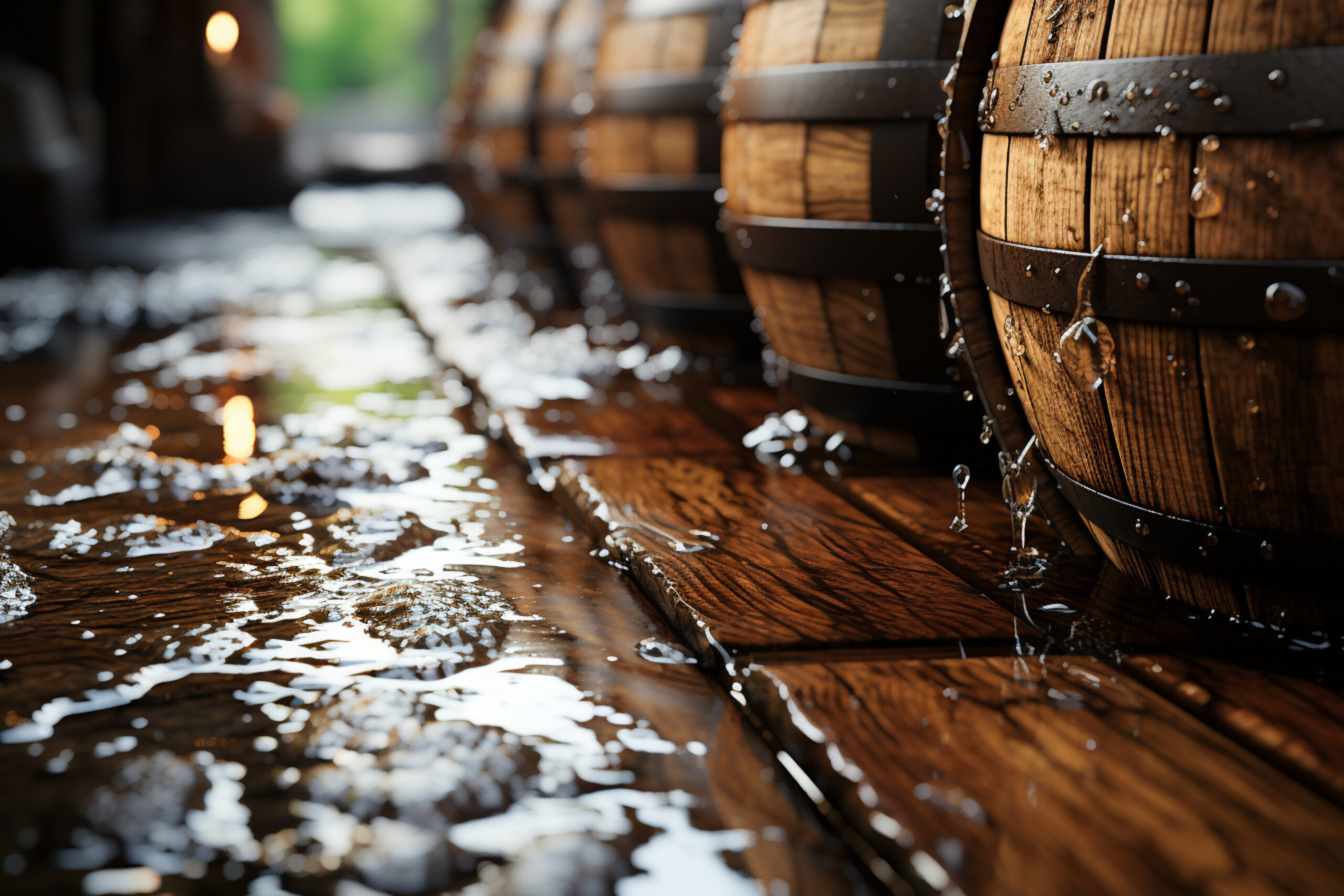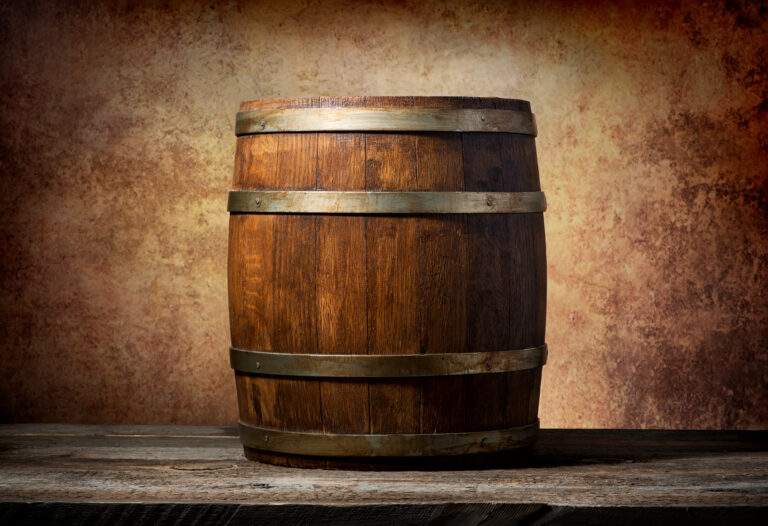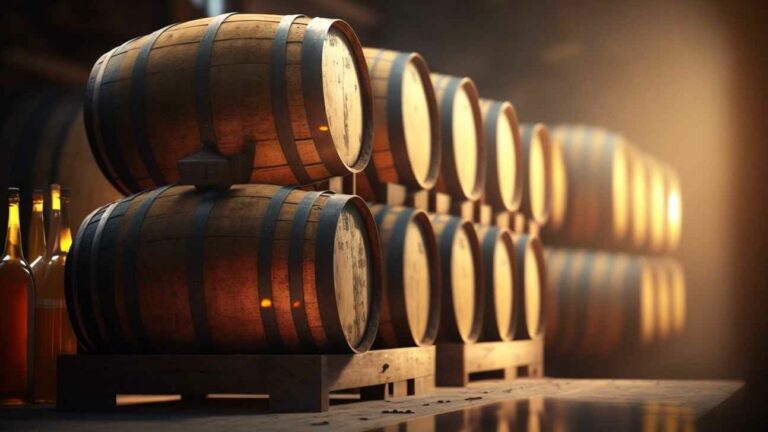Ever peek at your whiskey barrel and notice it’s crying more than usual? Don’t panic! This happens to the best of us and doesn’t necessarily mean your precious spirit has gone bad. Barrels leak; it’s just a fact of life in the world of spirit aging. But that doesn’t mean you should throw in the towel and resign yourself to losing valuable volume.
There are a few common reasons why whiskey barrels might start to leak or drip, and thankfully, a few straightforward things you can do to troubleshoot and fix the problem. Before you start blaming the cooperage or reaching for the bottles to empty your barrel, check out these tips. With some quick fixes, you’ll have your barrel back to aging whiskey in no time, ensuring your casks remain effective vessels for bourbon, scotch, and other aged spirits.
Common Culprits: Why Your Whiskey Barrel Is Leaking
Most often, when whiskey barrels start to leak, it’s due to one of these usual suspects:
- Improper or Loose Barrel Construction: If the staves (those wooden planks making up the barrel) aren’t fitted snugly together, or the metal hoops aren’t secure, tiny gaps can form, allowing your precious liquor to seep out. This is a common issue with barrel construction and can lead to significant liquid loss.
- Extreme Temperature Swings: Sudden shifts between heat and cold can cause the wood and metal components to expand and contract at different rates, loosening those crucial seals. Storing your barrels in a temperature-controlled environment is key to preventing this kind of barrel damage.
- Rough Handling or Drops: Just like us, barrels can get bruised! Physical impacts and stresses, whether from moving or positioning, can loosen barrel joints and seals over time, leading to whiskey leakage. Always handle your barrels with care to avoid compromising their structural integrity.
- Natural Wood Shrinkage: As barrels age, the wood can naturally shrink ever so slightly, creating tiny cracks. Applying a sealant, like beeswax or paraffin wax, to the outside of your barrels can help offset minor shrinkage and maintain barrel integrity.
- Bacterial Growth: Believe it or not, certain bacteria can feast on the sugars in the wood and alcohol vapors, slowly damaging the barrel wood. Sanitizing barrels before filling and proper storage helps prevent bacterial growth and associated damage, safeguarding your aged spirits.
With regular barrel inspections and the right care and storage conditions, most leaks in whiskey barrels can be avoided or minimized. But if a leak does spring up, don’t panic – there are ways to remedy the situation without losing the precious contents inside your cask.
Bung-Hole Blues? Checking for Leaks Around the Bunghole
If your whiskey barrel is leaking, don’t panic! It’s often an easy fix. First, make a beeline for the bunghole (that’s the hole on top of the barrel where you fill and empty it). This is typically the most likely spot for barrel leaks.
Did the bung (the stopper that goes into the bunghole) come loose or fall out? Simply replace it and secure it tightly. Still leaking? The bunghole itself might have warped or cracked. For small leaks, try applying food-grade wax, silicone, or beeswax sealant around the bunghole to patch things up.
For larger cracks, you’ll need to drain and rinse the barrel. Then, apply wood glue, wood filler, or a specialized barrel sealant, and clamp the staves (the barrel slats) until the sealant dries completely. After that, you can re-fill and re-seal the barrel.
If the problem persists, the entire barrel might need replacement. But don’t lose hope just yet! With some DIY barrel repair techniques, you can often get your leaky barrel back to being watertight and ready for aging whiskey in no time. Always keep your barrel in a stable environment, handle and fill it properly, and perform regular maintenance to prevent leaks in the first place. Your whiskey barrel is an investment in your spirit aging journey, so take good care of it, and it’ll reward you for years to come. Cheers to that!
Gap Inspection: Peeking at Your Barrel Staves
Inspecting the barrel staves (those individual wooden planks that form the barrel’s body) for any gaps or cracks is a crucial step when troubleshooting a leaky whiskey barrel.
Ideally, the staves should fit together tightly with no visible gaps. Run your fingers along both the inside and outside of the barrel to feel for any spaces between the staves. Any openings can allow oxygen to reach your whiskey, which is bad for the aging process, and of course, let your precious liquor seep out. For minor gaps, you can use a mallet and a wood wedge to gently tap the staves back into place. You might need to do this a few times as the wood swells.
Minor splits or cracks in the wood can also lead to leaks. Examine the barrel closely, especially near the ends and around the steel hoops. Small cracks can often be sealed effectively using beeswax, paraffin wax, or a commercial wood sealant and filler. For larger, more significant cracks, you might need to consider replacing the damaged staves.
If the char on the inner barrel surface has worn away or become uneven, or if staves are warped, it can prevent a proper seal. Charred or warped staves should be addressed; sometimes a barrel might need re-charring, or warped staves should be replaced to restore the barrel’s original shape and ensure proper aging conditions.
Ensuring tight-fitting, undamaged staves is vital for controlling oxygen exposure and preventing precious whiskey from seeping out of your barrel. With regular inspections and minor repairs, a high-quality whiskey barrel can provide many years of service in spirit maturation.
Sealing the Deal: Fixing Leaks with Wax or Silicone Sealant
If your barrel is leaking, it’s best to address it right away to avoid losing precious whiskey and prevent further damage. Here are a couple of DIY solutions to try for effective barrel repair:
Wax Sealant
Beeswax or paraffin wax can create a surprisingly effective seal for minor barrel leaks. First, clean and dry the area thoroughly around the leak. Then, apply the wax directly over the leak, spreading it at least an inch beyond the hole. Press firmly to ensure it adheres well. The wax will harden and seal the leak. You might need to reapply the wax every few months or if the seal shows signs of breaking.
Silicone Sealant
Waterproof silicone caulk can also seal small cracks and holes in your whiskey barrel. Again, clean and dry the area, then apply the caulk over the leak using a caulk gun. Smooth it out with a wet finger or tool. Allow it to cure as directed on the product, usually at least 24 hours. Silicone sealant will flex with the wood, providing a durable seal. For larger leaks, you might need to apply the sealant both inside and outside the barrel for comprehensive leak repair.
- Apply wax or caulk generously over and around leaks for the best possible seal.
- Always allow adequate time for the sealant to fully cure before refilling the barrel.
- Check the seal regularly and reapply as needed to prevent future leaks.
- For persistent leaks, you might need to sand down and refinish the area before re-sealing.
By sealing leaks promptly using wax, caulk, or other appropriate sealants, you can extend the life of your whiskey barrel and avoid losing any of your prized spirit. Perform regular maintenance, and your barrel should give you many more years of use. Letting leaks go untreated will only cause bigger headaches down the road for your whiskey aging process!
Climate Control: Monitoring Humidity for Your Barrel
It’s super important to keep a close eye on the humidity levels in the area where you’re storing your whiskey barrel. Why? Too much humidity can lead to the barrel staves swelling excessively, potentially causing leaks. On the flip side, not enough humidity, and you risk the wood drying out and cracking, also leading to leakage.
Check the humidity with a hygrometer, aiming for a sweet spot of 55-65% relative humidity. If it’s too high, consider using a dehumidifier to bring it down. If it’s too low, a humidifier might be your best friend. You could also try improving ventilation in the storage area or, if feasible, relocating the barrel to a more suitable environment.
The ideal humidity range can actually vary a bit depending on factors like the barrel size, the wood type (e.g., American oak, French oak), and how long your spirit is aging. So, keep a close watch, especially during the first few months. Making any necessary adjustments will help ensure your barrel ages properly and avoids unwanted leakage, keeping your whiskey maturation on track.
Ground Control: Ensuring Your Barrel Is Level
To ensure your whiskey barrel isn’t leaking, it’s crucial to make sure it’s sitting evenly on a flat, stable surface. An unleveled barrel can put undue stress on the staves and hoops, potentially causing leaks or cracks over time.
Check the Ground
First, make sure the area where your barrel is placed is perfectly level. Use a leveling tool to confirm the surface is even. If it’s on dirt or grass, flatten and compact the area thoroughly. For barrels resting on a wood deck or concrete, you might need to place pavers, sturdy boards, or a dedicated barrel stand under each barrel to distribute the weight evenly and prevent any stress points.
Add Shims as Needed
If your barrel is slightly unleveled, simple wooden shims can be incredibly helpful for stabilization. Place shims under the edges or any areas that need to be raised. Always use a level to double-check that the shims result in an even surface before placing the full weight of the barrel on them.
Rotate and Refill
If it’s practical, try to rotate and refill your whiskey barrel every few months. When emptying and refilling, seize the opportunity to check for any leaks or cracks and re-level the barrel as needed. Rotating helps prevent the barrel wood from drying out or becoming misshapen on one side. It also ensures the liquid interacts with more of the interior surface, which can contribute to better flavor development in your aged spirit.
Keeping a close eye on your barrel and ensuring it’s properly leveled and maintained will significantly help prevent unwanted leaks. A few extra minutes of care and adjustment can make a huge difference in the long run. Your patience will be richly rewarded when you have a barrel of perfectly aged whiskey with no leakage!
Inner Workings: Repairing Leaks From the Inside with Wine Corks
Once you’ve pinpointed the source of the leak inside your barrel, it’s time to patch it up. Wine corks, or even synthetic corks, can be surprisingly effective temporary seals for small cracks and holes. Here are the steps for this DIY barrel repair method:
- Find corks that fit snugly into the hole or crack. You want them to wedge in tightly to form an airtight seal.
- Gently tap the cork into place using a mallet. Make sure it’s secure but not too far in.
- Check that the seal is tight by filling the barrel with water. If it’s still leaking, you may need to use additional corks or a waterproof wood filler.
- Monitor the corks for a few days to ensure they stay securely in place as the wood swells. You might need to gently tap them in further.
For larger holes or cracks, you can also try using food-grade silicone sealant, wood putty, or waterproof wood glue in addition to the corks. Apply these in thin layers, allowing each to dry, until the leak is completely sealed.
Once sealed, test again with water to confirm the leak has been repaired before aging any liquid in the barrel. Remember to check all seals regularly and reapply or replace as needed. Corks and sealants may need to be refreshed every 6-12 months.
Using this temporary DIY method, you can often continue to use your leaky barrel for a few more aging cycles before needing to fully refurbish or replace it. With regular monitoring and resealing, a barrel repaired from the inside out can last many years. The key is catching and fixing any leaks promptly to avoid losing too much of your precious liquid gold!
Calling in the Big Guns: When to Contact a Professional Cooper
Sometimes, even with all your best efforts, a whiskey barrel leak is just too much to handle on your own. When your prized cask is seriously compromised, it’s definitely time to call in a professional cooper to assess and repair the damage. These skilled craftsmen specialize in building and repairing barrels, and they possess the proper tools, skills, and experience to fix serious leaks and other structural issues.
Wood Expansion and Contraction
Wooden barrels naturally expand and contract with changes in temperature and humidity. This constant movement can cause the metal hoops and staves to loosen, allowing valuable liquid to seep out. A cooper has the expertise to re-swell and re-hoop the barrel, creating that essential airtight seal once again for optimal spirit aging.
Structural Damage
Major leaks or significant cracks in the staves usually require disassembling part of the barrel to access and properly repair the damage. A cooper has the precise knowledge to carefully take apart a barrel, replace damaged components while keeping the remaining staves intact, and then expertly reassemble the barrel. They can even re-char the inside to prevent contamination and ensure your whiskey continues to develop its intended flavor profile.
Knowing When to Replace
If a barrel has extensive, irreparable damage or has simply reached the end of its usable life for aging spirits, a complete replacement may be necessary. A cooper can thoroughly inspect your barrel and provide an honest assessment, determining if repairs will be sufficient or if replacement is truly the best option. They can then source a new barrel of a similar size, wood type, and char level so you can safely transfer your contents and continue your aging process.
Rather than attempting DIY repairs that might not fully fix the issue or could even introduce infection into your spirit, trust the experts. A professional cooper has the proper training, tools, and experience to evaluate the condition of your whiskey barrel and perform the necessary repairs to ensure it is watertight and safe for continued use in spirit maturation. When in doubt, call a cooper – your whiskey deserves it!
FAQs: Your Leaky Barrel Questions Answered
Why is my whiskey barrel leaking?
There are a few possible reasons your barrel may be leaking:
- The barrel staves (the wooden planks that make up the barrel) may have shrunk over time, creating small gaps. As the wood dries out, these gaps can allow liquid to seep through. This is often related to humidity control and barrel seasoning.
- The barrel hoops (the metal rings that hold the staves together) may have become loose, also creating small openings.
- There could be minor damage or imperfections in the wood that have expanded as the wood swells and contracts with temperature changes, leading to whiskey leakage.
How do I fix a leaky whiskey barrel?
Here are some tips for barrel repair to try:
- Tighten the hoops. Use a hoop driver or hammer to gently tap the hoops, tightening the staves. Be very careful not to damage the wood.
- Swell the wood. Lightly dampen the outside of the barrel with water. This will cause the wood to swell, sealing up any small gaps. Let the barrel sit for 24 hours as the wood expands.
- Patch minor leaks. For small leaks, you can apply wax, wood glue, or waterproof wood filler over the opening on the inside of the barrel. Press firmly so it adheres well. This is a common DIY barrel fix.
- Re-char the inside. For persistent leaks, you may need to empty the barrel and have the inside re-charred by a cooperage (barrel maker). The controlled charring process will swell and seal the wood, restoring its integrity for spirit aging.
- As a last resort, for severe barrel damage, you may need to have sections of the barrel replaced by a professional cooper. This is often the only way to make the barrel watertight again for proper whiskey maturation.
With regular maintenance and monitoring, many common leaks can be repaired, and your whiskey barrel can continue aging spirits for years to come. But if leaks become unfixable, it may be time to retire the barrel from its aging duties.
Final Thoughts: Keep Calm and Age On!
Well, there you have it – some solid, helpful tips for troubleshooting a leaky whiskey barrel. Now you can get back to enjoying your whiskey aging journey like you’re meant to. Remember, a little bit of patience and some tender loving care (TLC) can go a long way in solving most barrel woes. If all else fails, don’t hesitate to call in a professional cooper to assess the situation – your prized whiskey is at stake, after all! Hopefully, these pointers have given you some ideas and reassurance. Keep calm and drink on, my friends. Your leaky barrel will be back in working order before you know it, ensuring your bourbon, scotch, or other aged spirits reach their full potential.







